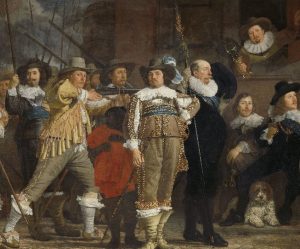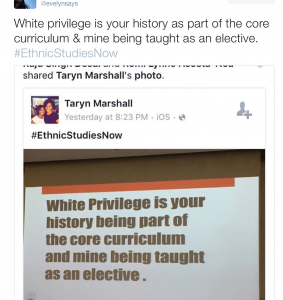The Research Project
Challenging Exclusion

Militiamen of the Company of Captain Roelof Bicker and Lieutenant Jan Michielsz. Blaeuw, Bartholomeus van der Helst, 1639
What do you see whilst looking at this detail of famous painting, by Militiamen of the Company of Captain Roelof Bicker and Lieutenant Jan Michielsz. Blaeuw by Bartholomeus van der Helst from 1639? Some readers may remember the painting from the Rijksmuseum, in which it hangs proudly on diplay in the main hall, claiming its place in (art-) history and the glory of Dutch artistry. But it is not the craftmanship, which has made me choose this image in order to begin to talk about WdKA makes a Difference. It is the short presumably younger person on the left next to the White Captain Roelof Bicker. Little is known about this young person of African descent, what is known however, that their story is part of a past, that will remain partly speculative. Knowledge, that seems not to be of relevance for contemporary art-historical discourses presented at contemporary Art Academia. But these histories on display and hidden to perfection in our curricula is only one aspect, of what this project is about.
In other words we are interested to achieve a wider spectrum of Representation of marginalised perspectives in the arts through content and display of creative practices. The idealistic premise is
A Twitter commentary by a US Higher education Student makes this very palpable: White Priviledge

I will use the opportunity afforded me here to elucidate my role as Applied Research Professor in Cultural Diversity at the Hogeschool Rotterdam (Creating 010/WdKA) and initiator of the project WdKA makes a Difference.
Creating 010 Research Center is a research centre that is devoted to taking the city as a place of research aiming to create connections between the discourses of the city and the teaching and research at the Hogeschool Rotterdam, or more specifically, the Willem de Kooning Akademie and Institute for Communication, Media and Information Technology.
Rotterdam is a place of multiplicity consisting of a plethora of cultures, ethnicities, beliefs and languages. The city constantly changes in terms of its demographics and cultures through socio-political and economic changes, immigration processes and globalization. Particularly art and design practices are dependent on knowledge and understanding of global trends, movements and transnational discourses. Contemporary creatives are, on the one hand, depending on local infrastructures but also on a strong international network. Within this set of competences, it is our aim to nurture criticality, which leads towards a greater inclusion of socio-cultural perspectives and adds a potential to decolonize creative practices and pedagogy. Critical has hence to be understood as a competence[1] which means that the more one understands the hybridity of creative practices and perspectives on art, the better one will be able to survive in this market of great competition. Motivated by the diverse demographic and Rotterdam as a city within a post-colonial context, I have repeatedly asked in my position: What does a curriculum, teaching staff and student body have to look like in order to meet these parameters of our societies and markets?
This question is informed by an understanding of Europe as a post-colonial site and art schools in the midst of it, which has not even started a process of decolonization. In other words it is an understanding of an art school and its pedagogy from a global and historical perspective, by which I mean, that the composition and hybridity of Western Societies – or the Global North – are grown out of the aftermath of Imperialism and Settler Colonialism. This not only includes the violent and exploitative history of that enterprise, which has created amongst other phenomena the Black Diaspora, but also has to be addressed on an ideological level because the way in which power is shared or distributed is still embedded within these dynamics and ideas. This includes knowledge production in all its forms and, in the case of the arts, the inclusion or exclusion of non-white artists or the particular framing of these artists, a subject that has been addressed by various scholars and artists for more than four decades. One art-historian who calls attention to this change in method is i.e. Darby English, when he writes:
[Citation] “It is no less convincing than ever to speak of Black artists as if they share an enterprise. […] it recommends a turn toward the subjective demands that artists place on the multiple categories they occupy, and that we grant this multiplicity right of place in our methodologies.”[2]
Cultural Diversity, however, is not only about an intrinsic change of methods and inclusion of voices that have been excluded. It is about creating a critical awareness of, and literacy[3] in, the specificities through which our positions in a society are historically produced and what these positions entail.
The re-occurrence of themes like the critique of white Supremacy and political strategies such as Feminism since the 1960’s, which keep reappearing in the contemporary, is not a coincidence, but a sign that we still have to work on the power structures in which we live that are constantly reproduced. It is also a sign to correct and further develop these concepts and methods in a context such as Rotterdam, which has not yet fully embraced these critical approaches.
The Cultural Diversity research team at the Hogeschool, Rotterdam is currently charged with examining the ways in which in- and exclusion is produced at the Willem de Kooning Akademie.
The project is called WdKA makes a Difference, and has been inspired by the larger research project Art.School.Differences – a project that is currently conducted at the Zurich University of Arts (ZHdK), the Geneva University of Art and Design (HEAD – Genève) as well as the Geneva University of Music (HEM – Genève). Like the research in Switzerland, my approach is to embrace the subject not only from an empiric, but also from a participatory action based perspective,[[4]] which means whilst we are looking at the issue, we are also part of the process.
Influenced by and reflecting on this research, embedded as we are in Rotterdam the second largest city in the Netherlands where 70% of the city’s youth has a migrant heritage, we are interested in:
What is the role of an art institution in Rotterdam? Is it about an ethnic, religious and/or class elite or is it about multiple identities that reflect not only Rotterdam’s demographics but also situate the students within the growing global competition in the creative markets? How can we as professionals, working within an art institution, enhance reflexive and inclusive thinking as well as pedagogy without reproducing exclusions? A question, that the sociologist Ellen Berrey foregrounds in her recently published article. Berrey also stresses, that even in the most well intended hands, Diversity training often fails to enhance equality through an almost exclusive focus on disadvantage i.e. particularly Black women.[5]
Challenging notions of exclusion is something higher education institutions have expressed a great desire for. Embracing inclusive practices and Diversity policies is seen as the way forward. These policies, while aiming to diversify the student body,[6] often fail to take into consideration the ideological changes that would be needed to make this transformation successful for individual students and the institution itself. This means, in the case of WdKA makes a Difference that the teaching and discussions with students and teachers, and the decolonizing work on the curriculum, are of equal importance for our analysis as the conducting of qualitative interviews. It is also an approach that includes the perspectives of teachers as researchers on Cultural Diversity, and thus comes out of the perspective of practitioners rather than of numbers and statistics.
[1] Steyn, Melissa (2010). Chapter 1 – Critical Diversity Literacy. Diversity awareness in 12 South African organizations, in: Ibid. (Ed.): Being Different together. Case studies on diversity interventions in some South African organizations, Cape Town: Intercultural and Diversity Studies of Southern Africa, pp. 15-43, available online: https://open.uct.ac.za/bitstream/item/3992/Being_different_together.pdf?sequence=1 (last accessed: 09.03.2016).
[2] English, Darby (2007): How to See a Work of Art in Total Darkness, Cambridge: MIT Press, p. 12
[[3] Comment by Art.School.Differences: Cf. contribution by Melissa Steyn on Critical Diversity Literacy in Reader 3. (De-)Kolonisierung der Kunsthochschule: Feministische und post_koloniale Kritik, antidiskriminatorische Methoden – (De-)coloniser l’enseignement artistique supérieur: critique féministe et post_coloniale, méthodes antidiscriminatoires, pp. xy-xy.]
[[4] Comment by Art.School.Differences: For this perspective we refer to the text Methods for De/Liberation by Carmen Mörsch in Reader 1. Ungleichheiten und Normativitäten im Feld der Kunsthochschule erforschen – Inégalité et normativité dans le champ de l’enseignement artistique supérieur: un état des lieux de la recherche, pp. xx-yy.
[5] Berrey, Ellen (2015): Diversity is for white people: The big lie behind a well-intended word, in: Salon (26.10.2015), available online: http://www.salon.com/2015/10/26/diversity_is_for_white_people_the_big_lie_behind_a_well_intended_word/ (last accessed: 09.03.2016). Also see: Berrey, Ellen (2015): The Enigma of Diversity – The language of race and the limits of racial justice, Chicago/London: University of Chicago Press.
[6] Seefranz, Catrin/Saner, Philippe (2012): Making Differences. Schweizer Kunsthochschulen. Explorative Vorstudie, Zürich: Institute for Art Education. Available online: http://www.kultur-vermittlung.ch/zeit-fuer-vermittlung/download/materialpool/MFV0103.pdf (last accessed: 09.03.2016).